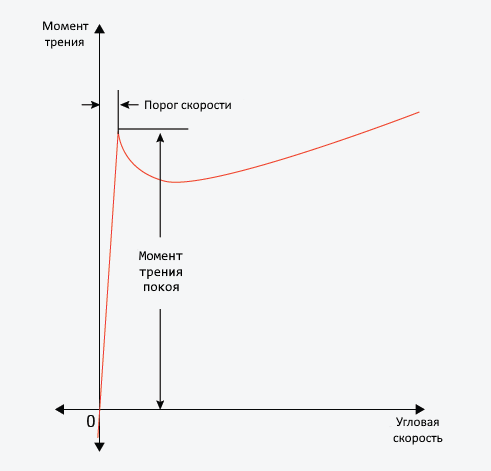Rotational Friction
Friction in contact between rotating bodies.
blockType: AcausalFoundation.Mechanical.Rotational.Elements.Friction
Path in the library: |
Description
Block Rotational Friction represents the friction at contact between rotating bodies. The friction torque is modelled as a function of relative velocity and is calculated as the sum of the components of fluid, viscous and mixed friction as shown in the following figure.
Mixed friction, or Stribeck friction, , represents the characteristic with a negative slope occurring at low velocities. Dry, or Coulomb friction , results in constant torque at any speed. Viscous friction counteracts motion with torque directly proportional to relative speed. The sum of mixed and dry friction near zero velocity is often referred to as rest friction . Friction is approximated by the following equations:
Where:
-
- friction moment.
-
- moment of dry (Coulomb) friction.
-
- rest friction moment.
-
- critical velocity.
-
- velocity threshold for Stribeck friction.
-
- Coulomb velocity threshold.
-
and are the absolute angular velocities of the R and C ports, respectively.
-
- relative angular velocity.
-
- viscous friction coefficient.
The exponential function used in the Stribeck part of the friction force equation is continuous and decays at velocity values greater than the critical angular velocity.
The hyperbolic tangent function used in the Coulomb part of the equation ensures that the resulting function is smooth and continuous when passing through , but quickly reaches its full value at non-zero velocities.
The positive direction of the block is from port R to port C. This means that if the velocity of port R is greater than the velocity of port C, the block transmits force from R to C.
Ports
R is a mechanical rotary port
`rotational mechanics
Mechanical rotational port, corresponds to a moving body.
C is a mechanical rotational port
`rotational mechanics
Mechanical rotational port, corresponds to a stationary body.
Parameters
Breakaway friction torque, N*m - resting friction torque
`25.0 N*m (by default)
`25.0 N*m (by default)
Resting friction torque. Must be greater than or equal to the Coulomb friction force parameters.
Breakaway friction velocity, rad/s - critical angular velocity for Stribeck friction
0.1 rad/s (by default).
The angular velocity at which Stribeck friction reaches its maximum. At this point, the sum of Stribeck friction and Coulomb friction is equal to the value of the Breakaway friction torque parameter. This parameter sets a velocity threshold that affects the trade-off between simulation accuracy and velocity.

Coulomb friction torque, N*m - dry friction torque
20.0 N*m (by default)
Coulomb friction torque, i.e. friction opposing rotation with constant torque at any speed.
Viscous friction coefficient, N*m/(rad/s) - viscous friction coefficient
0.001 N*m/(rad/s) (by default).
Coefficient of proportionality between friction torque and relative angular velocity. The value of the parameters must be greater than or equal to zero.
Initial value of rotational velocity, rad/s - initial value of angular velocity
0.0 (by default).
Initial value of angular velocity.
Initial value of torque, N*m - initial value of torque
0.0 (By default)
Initial value of torque.

